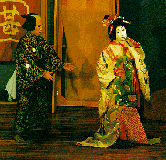 Japanese Kabuki Theater
Japanese Kabuki Theater
A theater of escapism
Home World Cultures FRAMED?
In 1603's closed Japan female Zumo Shrine attendant Okuni led her company of women in light comedy and dance in Kyoto's dry Kamogawa riverbed. Gaining national recognition the genre was called Kabuki, meaning extraordinary. The Genroku period (1688 - 1704) is when most kabuki traditions developed. Kabuki although extraordinary as its name implies shares many similarities with Western theater.
Bunraku and kabuki are to Noh as Broadway plays and musicals are to grand opera. As in the West, plays are repertory although good new material is accepted. Like Western audiences, Japanese audiences go to theaters to see actors act, cheering their favorite actors. Japanese social classes met in entertainment districts. Kabuki themes revolve mostly around ordinary people outwitting rulers in love or combat. Merchants, by Japanese law not allowed to wear bright clothes or change professions, considered lowest of classes despite their wealth because they sold things instead of producing them, were especially attracted to kabuki's colorful, stylized, traditional melodrama. Many kabuki plays are adapted from bunraku. Early kabuki had no real scripts. Actors improvised from scene outlines.
Kabuki plays are mostly historical, domestic or adapted. A popular theme is the Ako incident (Treasury of Loyal Retainers, or 47 Ronin) In early 1701 Asano, daimyo of Ako, lost his temper, drew his sword and struck at shogun court official Kira several times, only producing a small scratch, still a capital offense. Asano, executed, left his faithful samurai unemployed, or ronin. 47 of them plotted revenge against Kira almost 2 years, then raided Kira's residence one night, killing several of his servants and samurai. They found Kira cowering in a charcoal bin and cut off his head. They were caught and executed. News of the event spread although Tokugawa censored references to it. Stories avoiding censorship are set in different eras, still obvious to Japanese audiences. Samurai are still popular as Japanese cowboys and Indians.
Women, feared too suggestive, were banned from kabuki in 1629 and young men took over their roles. Actors specialized in playing Onnongata, female characters, as opposed to portraying the opposite sex in the West as part of the play's story line. Fights still broke out over them and they too were banned in 1645. Women were banned from the public stage in the West from classical times until 1641. With today's instant worldwide communication, nonwestern as well as Western women refuse to accept a second-class place in society, and rightly so. Women's kabuki clubs perform successfully both in Japan and the West. Both these bans were later lifted.
First kabuki theaters were open air. Wealthy patrons had private boxes with curtains. The poor crowded standing room below. Today's bottom level audiences sit in fenced groups of 9, balcony seats cheaper. Kabuki's traditional curtain, always traverse, has black, red-brown and green vertical stripes. After the mid-1600s Japan's cultural center gradually shifted from Kamigata to Edo. Kamigata playwright Namiki Shozo I (1730-73) invented the revolving stage (mawaributai) later introduced abroad, allowing rapid scene changes such as flashbacks without interrupting plot sequence.
The main actor enters from back of the theater along the hanimichi, the flower road originally built for actors to receive gifts. Actors enter and exit on the hanimichi, often delivering their first long speech (tsurane) after announcing character names and genealogy (naming or nanori) Some plays continue here after the curtain is drawn. Kari-Hanamichi (Sub Stage Road) used when two principal roles appear or disappear. Today it's used when needed, due to audience decrease. Anther main and smaller bridges lead offstage. Musicians, singers and narrators sit in full audience view. Kabuki musical instruments are mostly samisen, flute, drums and tsuke (wooden blocks)
Kabuki centers around the actor, trained from childhood as western children learn at school or in after-school recreation. Besides singing and dancing, kabuki actors learn traditional forms (kata) including the mie, an exaggerated pose often accompanied by tsuke, at a high point in the story when the character shows his emotions, otherwise played against. The mie, part of Japanese culture, is often reproduced in manga (comic books) and anime (cartoons)
Kabuki and Western roles are generic, serving a purpose in the story. Kabuki character types are assigned their own costumes, wigs and makeup. Kabuki dialogue ranges from extremely stylized jidah mono (formalized speech) to intensely realistic sewa-mono (colloquial speech) Monologues and most lines are in 7 - 5 syllable patterns similar to Haiku, delivered in a Kabuki tempo adapted from bunraku.
Kabuki families go back many generations. Kabuki actors earn the names of their predecessors, adopting them in a naming ceremony. Western actors adopt unique stage names. As in the West, much can be learned about an actor by studying plays written for him. Kurogo (men in black) handle props onstage while the curtain is open and serve also as prompters. Western stagehands are mostly offstage, sometimes appearing and taking lines as costumed extras.
BOOKS Suggested books or whatever your library has available.
Time-Life Books Early Japan Great Ages of Man series
Kabuki - Yasuji Toita
The Kabuki Theatre - Earle Ernst
The Art of kabuki - Samuel L Leiter
LINKS
Nagoya Musume Kabuki women
Grand Kabuki shows, tickets, services
Kabuki: Frozen features in a floating world
Kabuki fact sheet
Kabuki for everyone
Uta, Mai, Waza: Kabuki
History of kimonos
Japan Access